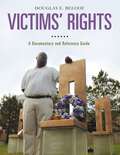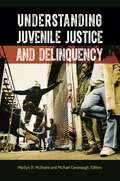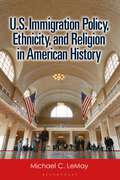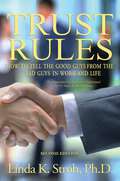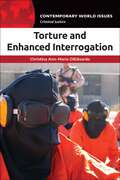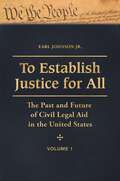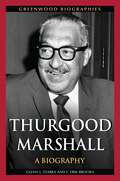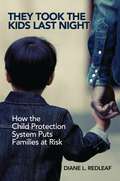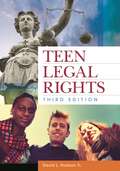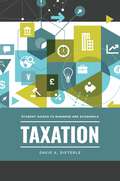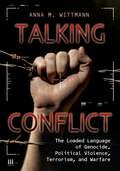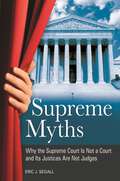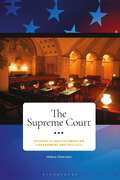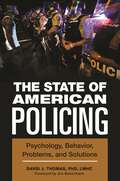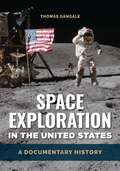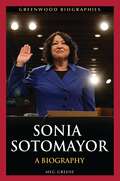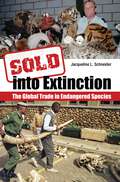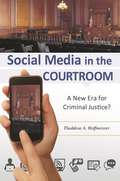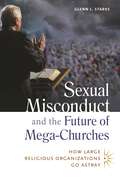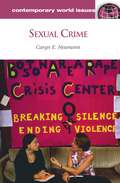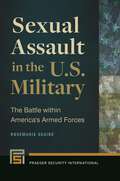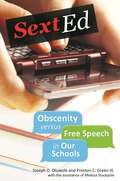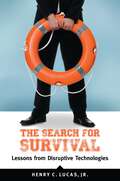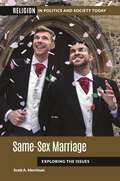- Table View
- List View
Victims' Rights: A Documentary and Reference Guide (Documentary and Reference Guides)
by Douglas E. BeloofThis invaluable one-stop reference source supplies students and general readers with historical and current information on the victims' rights revolution in the United States, providing analysis on everything from human rights reports to Supreme Court cases that allows the reader to fully understand these documents.Victims' rights represent the greatest change in the criminal justice system within the last 30 years. Victims' Rights: A Documentary and Reference Guide traces the origins, evolution, and results of the victims' rights movement. It puts victims' rights in a legal, historical, and contemporary context, and comprehensively collects important victims' rights documents in a single volume—perfect for students as well as general readers.Bringing together dozens of varied documents such as presidential task force reports and recommendations, Supreme Court cases, state constitutions, human rights reports, critical articles, and political documents, this book is an indispensable resource for those seeking to understand the origins and modern consequences of American victims' rights policy. The author's accompanying commentary and analysis helps the reader to gain a complete comprehension of the significance of these documents, while numerous bibliographic sources provide additional resources for interested readers.
Understanding Juvenile Justice and Delinquency
by Marilyn D. McShane Michael CavanaughThis book provides a comprehensive, cutting-edge look at the problems that impact the way we conduct intervention and treatment for youth in crisis today—an indispensable resource for practitioners, students, researchers, policymakers, and faculty working in the area of juvenile justice.Understanding Juvenile Justice and Delinquency provides a concise overview of the most compelling issues in juvenile delinquency today. It covers not only the range of offenses but also the offenders themselves as well as those impacted by crime and delinquency. All of the chapters contain up-to-date research, laws, and data that accurately frame discussions on youth violence, detention, and treatment; related issues such as gangs and drugs; the consequences for scholars, teachers, and students; and best practices in intervention methods.The book's organization guides readers logically from the broader definitions and parameters of the study of juveniles to the more specific. The volume leads with an explanation of the relationship between victimization and juvenile behavior and sets up boundaries of the arenas of delinquency—from the family to the streets to cyberspace. The book then focuses on more specific populations of offenders and offenses, including recent, emerging issues, offering the most accurate information available and cutting-edge insight into the issues that affect youth in custody and in our communities.
U.S. Immigration Policy, Ethnicity, and Religion in American History
by Michael C. LeMayThis invaluable resource investigates U.S. immigration and policy, making links the ethnic and religious affiliations of immigrants to the United States to trends in immigration, both legal and unauthorized.U.S. Immigration Policy, Ethnicity, and Religion in American History is rich with data and document excerpts that illuminate the complex relationships among ethnicity, religion, and immigration to the United States over a 200-year period. The book uniquely organizes the flow of immigration to the United States into seven chapters covering U.S. immigration policy making; the Open Door Era, 1820–1880; the Door Ajar Era, 1880–1920; the Pet Door Era, 1920–1950; the Dutch Door Era, 1950–1985; the Revolving Door Era, 1985–2001; and the Storm Door Era, 2001–2018. Each chapter analyzes trends in ethnicity or national origin and the religious affiliations of immigrant groups in relation to immigration policy during the time period covered.
Trust Rules: How to Tell the Good Guys from the Bad Guys in Work and Life
by Linda K. StrohTrust is at the root of all positive relationships. This accessible and empowering book teaches how to form an inner circle of trusted confidants in your workplace and at home that will allow you to live a more peaceful and more effective life, reduce stress, and better deal with negative emotions.Building trust is crucial for effective leadership, and trusting others is a necessary part of working with others. But knowing whom to trust—and whom not to trust—eludes many people. A surprising number of people report that being betrayed by someone in their "inner circle" either at work or in their personal lives is one of the most devastating things they have endured. Lack of trust is also expensive in that it costs companies money to surveil employees; and in our personal lives, if we live with people we cannot trust, we expend needless amounts of energy protecting ourselves from these untrustworthy people. How do we increase trust, bounce back from betrayal, and form alliances and positive relationships with those who ARE trustworthy?This book provides a unique examination of trust and its often-overlooked importance to our work and personal lives. It identifies the characteristics of a trusting relationship, considers the decision-making process that people should make before granting individuals admission to their own "inner circle," and teaches how to tell the "good guys" from the "bad guys" in our work environments and life in general. This revised and updated edition contains new information on the negative mental and physical aspects of telling lies; how to better manage our emotions, which allows us to become "better guys" ourselves; strategies for building more trusting relationships in our families; and how trust works—and doesn't work—online in the Internet age. It also includes a useful "Family Board Meeting" tool for having family meetings in a way that encourages honest and open dialogue between family members regardless of age or family structure.
Torture and Enhanced Interrogation: A Reference Handbook (Contemporary World Issues)
by Christina Ann-Marie DiEdoardoA comprehensive look at torture, this book examines societal understanding of its use, how we got here, and how it might be regarded in the future.Torture and Enhanced Interrogation: A Reference Handbook begins with an overview of the history of torture, beginning in Ancient Greece and continuing to Guantanamo Bay and beyond. After grounding the reader in the historical fundamentals, the work goes on to examine the key controversies that surround the use of torture, including but not limited to whether it should be used at all as an aid to interrogation or to procure testimony. Then, the book presents the views of several outside contributors with personal experience or special expertise in the area. The book achieves a balance of profiles of those persons and organizations that have played a role in the development of our understanding of torture, a data and documents section, and an annotated bibliography for future research, as well as an event timeline and glossary of key terms. This volume is aims to present facts in as objective a way as possible while providing readers with the resources they need for further study.
To Establish Justice for All [3 volumes]: The Past and Future of Civil Legal Aid in the United States [3 volumes]
by Earl JohnsonFor over a century, many have struggled to turn the Constitution's prime goal "to establish Justice" into reality for Americans who cannot afford lawyers through civil legal aid. This book explains how and why.American statesman Sargent Shriver called the Legal Services Program the "most important" of all the War on Poverty programs he started; American Bar Association president Edward Kuhn said its creation was the most important development in the history of the legal profession. Earl Johnson Jr., a former director of the War on Poverty's Legal Services Program, provides a vivid account of the entire history of civil legal aid from its inception in 1876 to the current day. The first to capture the full story of the dramatic, ongoing struggle to bring equal justice to those unable to afford a lawyer, this monumental three-volume work covers the personalities and events leading to a national legal aid movement—and decades later, the federal government's entry into the field, and its creation of a unique institution, an independent Legal Services Corporation, to run the program. The narrative also covers the landmark court victories the attorneys won and the political controversies those cases generated, along with the heated congressional battles over the shape and survival of the Legal Services Corporation. In the final chapters, the author assesses the current state of civil legal aid and its future prospects in the United States.
Thurgood Marshall: A Biography (Greenwood Biographies)
by Glenn L. Starks F. Erik BrooksThis book provides a detailed examination of the life and legal legacy of Supreme Court Justice Thurgood Marshall, including a discussion of the many legal cases in which he was involved.Thurgood Marshall was the first African American Supreme Court Justice. As a lawyer, he won the Supreme Court Case Brown v. Board of Education of Topeka that integrated all public schools in the United States. But Marshall's contributions extend far beyond significantly advancing the civil rights movement in this nation.Thurgood Marshall: A Biography discusses the life of Supreme Court Justice Thurgood Marshall in a chronological fashion, and then discusses his legacy after death. Students at all grade levels—including undergraduate and graduate college students—as well as historians and general readers interested in African American history , civil rights, or the U.S. legal system will find this book insightful and useful.
They Took the Kids Last Night: How the Child Protection System Puts Families at Risk
by Diane L. RedleafThis account of six families whose children were wrongly seized by child protection services vividly illustrates the constitutional balancing act where medicine, family interests, and child safety can clash.They Took the Kids Last Night shows a rarely exposed side of America's contemporary struggle to address child abuse, telling the stories of loving families who were almost destroyed by false allegations—readily accepted by caseworkers, doctors, the media, and, too often, the courts. Each of the six wrongly accused families profiled in this book faced an epic and life-changing battle when child protection caseworkers came to their homes to take their kids. In each case, a child had an injury whose cause was unknown; it could have been due to an accident, a medical condition, or abuse. Each family ultimately exonerated itself and restored its family life, but still bears scars from the experience that will never disappear. The book tells why and how the child protection system failed these families. It also examines the larger flaws in our country's child protection safety net that is supposed to sort out the innocent from the guilty in order to protect children.
Teen Legal Rights
by David L. Jr.The only book of its kind to examine all aspects of a young adult's legal rights at school, at work, and at home, including recent developments in teen-oriented legislation.Widespread Internet use and evolving privacy concerns compromise the legal rights of teenagers. While smart phones, social networking, and online music downloading pose new legal complications for teens and their parents to navigate, the Supreme Court has grappled with rights concerning every aspect of a young adult's life long before now. This newly updated text, written in accessible language and presented through an informal FAQ format, simplifies the laws, rights, and constitutional implications affecting young people today.In an easy-to-understand, non-intimidating style, First Amendment scholar David L. Hudson Jr. provides an authoritative analysis of the judicial system, utilizing actual court cases and legal arguments to help teens better understand their rights under the law. Additionally, the text presents recent changes and interpretations of legal areas still in debate. This third edition features an updated examination of recent topics that includes cyberbullying, "sexting," social media privacy, and illegal downloads of online content.
Taxation (Student Guides to Business and Economics)
by David A. DieterleThis engaging and accessible book is a must-read for every taxpayer, young and old. It explores the many forms of taxation; how taxes are created, collected, and spent; and why certain aspects of taxation are so controversial."In this world, nothing can be said to be certain, except death and taxes." Benjamin Franklin wrote this now-famous quote more than 200 years ago, and taxation remains just as important (and inevitable) today as then. Taxes are a fact of life for almost everyone, and the public goods and services they pay for are enjoyed by all citizens. While taxes are undeniably necessary, the specifics of what should be taxed, who should pay taxes, and at what rate remain hotly debated by economists, government officials, and regular citizens. The first in Greenwood's new Student Guides to Business and Economics series, Taxation gives readers an in-depth yet reader-friendly look at one of economics' foundational concepts. Using simple language and relevant real-world examples, the book explores the different forms of taxation, the necessary components of any tax, how taxes are created and collected, and much more. It also highlights contemporary controversies related to taxation, including whether or not "sin taxes" actually discourage unwanted behaviors like smoking and how best to simplify the tax filing process.
Talking Conflict: The Loaded Language of Genocide, Political Violence, Terrorism, and Warfare
by Anna M. WittmannIn today's information era, the use of specific words and language can serve as powerful tools that incite violence—or sanitize and conceal the ugliness of war. This book examines the complex, "twisted" language of conflict.Why is the term "collateral damage" used when military strikes kill civilians? What is a "catastrophic success"? What is the difference between a privileged and unprivileged enemy belligerent? How does deterrence differ from detente? What does "hybrid warfare" mean, and how is it different from "asymmetric warfare"? How is shell shock different from battle fatigue and PTSD? These are only a few of the questions that Talking Conflict: The Loaded Language of Genocide, Political Violence, Terrorism, and Warfare answers in its exploration of euphemisms, "warspeak," "doublespeak," and propagandistic terms.This handbook of alphabetically listed entries is prefaced by an introductory overview that provides background information about how language is used to obfuscate or minimize descriptions of armed conflict or genocide and presents examples of the major rhetorical devices used in this subject matter. The book focuses on the "loaded" language of conflict, with many of the entries demonstrating the function of given terms as euphemisms, propaganda, or circumlocutions. Each entry is accompanied by a list of cross references and "Further Reading" suggestions that point readers to pertinent sources for further research. This book is ideal for students—especially those studying political science, international relations, and genocide—as well as general readers.
Supreme Myths: Why the Supreme Court Is Not a Court and Its Justices Are Not Judges
by Eric J. SegallThis book explores some of the most glaring misunderstandings about the U.S. Supreme Court—and makes a strong case for why our Supreme Court Justices should not be entrusted with decisions that affect every American citizen.Supreme Myths: Why the Supreme Court is Not a Court and its Justices are Not Judges presents a detailed discussion of the Court's most important and controversial constitutional cases that demonstrates why it doesn't justify being labeled "a court of law."Eric Segall, professor of law at Georgia State University College of Law for two decades, explains why this third branch of the national government is an institution that makes important judgments about fundamental questions based on the Justices' ideological preferences, not the law. A complete understanding of the true nature of the Court's decision-making process is necessary, he argues, before an intelligent debate over who should serve on the Court—and how they should resolve cases—can be held. Addressing front-page areas of constitutional law such as health care, abortion, affirmative action, gun control, and freedom of religion, this book offers a frank description of how the Supreme Court truly operates, a critique of life tenure of its Justices, and a set of proposals aimed at making the Court function more transparently to further the goals of our representative democracy.
The Supreme Court (Student Guides to American Government and Politics)
by Helena SilversteinThis accessible guide to the U.S. Supreme Court explains the Court's history and authority, its structure and processes, its most important and enduring legal decisions, and its place in the U.S. political system.A 2018 Pew Research Center poll found that while 78 percent of Democrats and Democratic-leaning independents believed that the Supreme Court should base its decisions on the "modern" meaning of the Constitution, 67 percent of Republicans and Republican-leaning independents asserted that Justices should rely on the Constitution's "original meaning."The Court often is the final arbiter of polarizing battles that originate in other branches of government. At the same time, however, its structural insulation from Congress, the Presidency, and electoral politics make the Supreme Court—at least in theory—well positioned to rise above the rough-and-tumble of politics. This book examines the power of the Supreme Court in America's system of democratic governance in several ways. These include: reviewing debates over whether justices should interpret the Constitution in line with its "original meaning" or in accordance with present-day understandings; exploring the processes and factors that shape how cases are chosen and decided; considering contentious battles over the selection of justices; and examining the impact of the Court on American culture and society.
Steroids: History, Science, and Issues (The Story of a Drug)
by Joan E. Standora Alex Bogomolnik Malgorzata SlugockiProviding a significant source of information for upper high school and community college students concerning steroids and their derivatives, this book provides a holistic overview of this controversial class of drugs.The risks of recreational steroid use are often ignored or misunderstood by those who try them. At the same time, the therapeutic use of steroids can be dangerous when they're used incorrectly. Part of the Story of a Drug series, this timely book is specifically tailored to address the questions and concerns of young people, providing readers with an accessible source of information for understanding steroidal drugs.Chapters cover the history of steroids, including the development of synthetic steroids, steroid biochemistry, and the drugs' therapeutic functions, notably the importance of natural steroids in maintaining human life. The book discusses the current state of recreational use among athletes and students and of the dangers of misuse and overdose, and covers legal and governmental regulations relative to both therapeutic and recreational use of the drugs. The reader will come away from this volume with a comprehensive understanding of the pros and cons of steroid use based on current research, and grasp the possible risks—medical and legal—related to misuse of these powerful drugs.
The State of American Policing: Psychology, Behavior, Problems, and Solutions (Forensic Psychology)
by David J. ThomasWritten by a veteran police officer turned college professor, this modern-day study of American policing covers hot-button issues including police use of deadly force against and bias toward minorities.Grounded in research of historical and current events, this text examines police practices and the psychological impact that those practices have on minority communities. Author David J. Thomas, a retired police officer and associate professor of criminal justice, looks at and beyond historical perspectives to address many of today's most controversial issues central to minority communities. Topics covered include the repeated failure to convict officers for fatally shooting unarmed subjects, the rise of heated debates between the Black Lives Matter and Blue Lives Matter movements, the militarization of police agencies, and police response to protests by NFL players. The text also offers insight into the psychology of race, police culture, implicit bias, and the decision to use deadly force. Thomas additionally examines possible solutions to these problems. College students, researchers, academics, and readers interested in politics will find this work informative and thought-provoking.
Space Exploration in the United States: A Documentary History
by Thomas GangaleThis select volume of historical documents is organized chronologically, spanning from 1914 to the present. Divided into eight chapters, it includes a narrative introduction to each historical period.This collection of historical documents provides insight into the history of the United States in its pursuit of the peaceful uses of outer space, with emphasis on the manned space program of the National Aeronautics and Space Administration, as well as commercial American activities supporting human spaceflight in the early 21st century. Rocketry and space technology have served varied goals throughout the Space Age: pure research, as well as research applied for national security, national prestige, and commercial profit. There have been varied actors as well, among them individuals supported by philanthropists as well as governments, intergovernmental organizations, international consortiums, and for-profit corporations. This book focuses on space exploration, and in particular, human space exploration, leading to the questions, "Why have humans gone into outer space in the past?" and "Why will they do so in the future?" These documents help readers to examine the variety of fascinating answers to those questions.
Sonia Sotomayor: A Biography (Greenwood Biographies)
by Meg GreeneThis insightful biography introduces readers to Justice Sonia Sotomayor, a remarkable woman with a single-minded pursuit of educational excellence, who rose from poverty in a Bronx housing project to a seat on the U.S. Supreme Court.Sonia Sotomayor: A Biography is an overview of Justice Sotomayor's life and career from her childhood to her ascent to the Supreme Court. It is also an early assessment of her performance on the court, her relationships with her colleagues, and the particular influence she is likely to exert on future decisions.Sharing an inspirational, rags-to-riches story, the book begins with Sotomayor's childhood in an East Bronx housing project. It follows her to Princeton, where she was a student activist, and to Yale Law School. Equally important to an understanding of this influential judge is the discussion of her career as a prosecutor for the City of New York and as a judge in the District Court for the Southern District of New York and the Second Circuit Court. Examining her reputation as a tough but fair jurist, the book explores the influence of these years which, at the time of her appointment, established her as the only Supreme Court justice with experience as a trial judge.
Sold into Extinction: The Global Trade in Endangered Species (Global Crime and Justice)
by Jacqueline L. SchneiderThis revealing and compelling title analyzes the illegal trade in endangered species from a criminological viewpoint and presents specific crime reduction techniques that could help save thousands of species from extinction.The illegal trade in endangered species is a worldwide problem that involves not only animals but also plants, and it contributes to troubling factors such as organized crime as well as the further decline of the earth's natural climate. This book explores the extensive endangered species illegal market, spotlighting the worldwide nature and extent of the problem, and presents revealing case studies of terrestrial, marine, plant, and avian species.Sold into Extinction: The Global Trade in Endangered Species focuses attention on the plight of endangered wild flora and fauna as well as the specific illegal acts committed against them that have long and largely been ignored by criminology. The author provides a fresh look at the topic by presenting it within a crime reduction framework, an approach rarely taken by those with traditional criminological or conservation backgrounds, demonstrating how an innovative strategy to reduce illegal market activities can simultaneously further the conservation of these endangered species. International treaties, national and domestic laws, and international policing efforts pertaining to crimes involving endangered species are also examined.
Social Media in the Courtroom: A New Era for Criminal Justice?
by Thaddeus A. HoffmeisterSocial media hasn't just changed society—it's changing the way in which criminal law is prosecuted, defended, and adjudicated. This fascinating book explains how.While social media has become embedded in our society as a way to stay connected with friends, it serves another important purpose: to support the prosecution and defense of criminal cases. Social media is now used as proof of a crime; further, social media has become a vehicle for criminal activity. How should the law respond to the issue of online predators, stalkers, and identity thieves? This book comprehensively examines the complex impacts of social media on the major players in the criminal justice system: private citizens, attorneys, law enforcement officials, and judges. It outlines the many ways social media affects the judicial process, citing numerous example cases that demonstrate the legal challenges; and examines the issue from all sides, including law enforcement's role, citizens' privacy issues, and the principles of the Fourth Amendment. The author also shines a critical spotlight on how social media has enabled new types of investigations previously unimagined—some of which present ethical problems.
Sexual Misconduct and the Future of Mega-Churches: How Large Religious Organizations Go Astray
by Glenn L. StarksWhy have multiple mega-church leaders—Ted Haggard and Bishop Eddie Long, for example—committed acts of sexual misconduct? This book discusses the reasons in depth and examines how these acts are impacting the future of megachurches.Mega-churches—churches with congregations that number in the thousands of worshippers—are growing in popularity in America and around the world. Shockingly, a growing number of megachurch leaders have committed acts of sexual misconduct. While these scandalous crimes have received much attention through the media, literature that examines the topic in detail has been lacking. This book examines the various aspects of sexual misconduct by megachurch leaders, providing a comprehensive review of the topic that discusses the direct and indirect reasons for these crimes.The book provides unbiased, factual coverage of megachurch sexual abuse cases, covering issues surrounding the victims in specific cases, the role of the church, and notable ministers, such as Ted Haggard of New Life Church, Colorado Springs, CO; Bishop Eddie Long of New Birth Missionary Baptist Church, Lithonia, GA; and Joe Barron of Prestonwood Baptist Church, Dallas, TX. The author also discusses how these incidences have impacted societal perceptions of religion, and large churches, and religious organizations, and provides recommendations to curb future cases of sexual abuse within megachurches.
Sexual Crime: A Reference Handbook (Contemporary World Issues)
by Caryn E. NeumannA contemporary, fact-filled resource on the historical, legal, medical, and political aspects of a wide variety of sexual crimes.Authoritative and informative, Sexual Crime: A Reference Handbook offers a thoroughly up-to-date report on an issue of extraordinary urgency. It is an expert introduction to a variety of often misunderstood crimes.Sexual Crime begins with a background chapter outlining the causes and definitions of sexual crime, legal and cultural attitudes over the past three centuries, and common myths surrounding this sensitive subject. It then offers wide ranging coverage of issues, including date rape, crimes involving male victims, rape in prison, female perpetrators, medical treatments, political ramifications, and other contemporary issues.
Sexual Assault in the U.S. Military: The Battle within America's Armed Forces (Praeger Security International)
by Rosemarie SkaineThis book provides an in-depth analysis of sexual assault in the military from historical and contemporary perspectives, offering suggestions that could change the existing culture and approaches that will reduce or eliminate sexual assault in the armed forces.Sexual assault has been an aspect of the U.S. military historically and is today widely recognized as a significant problem with far-reaching repercussions. How does sexual assault negatively impact not only the victims themselves but also the U.S. military's strength, readiness, and morale? This book answers these questions and documents the problems with reporting and prosecuting sexual assault complaints within our armed forces, examines the current policy and laws to identify what changes are needed, and analyzes recent efforts to prevent sexual assault.Author Rosemarie Skaine introduces the subject with a historical perspective that covers women, men, gays and lesbians, and non-military personnel as the subjects of sexual assault and provides readers with clear definitions of sexual harassment and sexual assault. The chapters explain how sexual assault negatively affects the military's performance as a whole, thereby serving to undermine national security; and covers preventative approaches and legislation intended to change the current military culture. The book also includes a bibliography, tables of key figures, and footnotes and endnotes that fully document the data presented.
Sext Ed: Obscenity versus Free Speech in Our Schools
by Joseph Oluwole Preston C. IIISchools need to be able to regulate sexting, but at what point are administrators infringing on students' rights? Is teenage sexting a violation of child pornography laws? This book tackles these tough issues and others.In several states, teenagers who engage in "sexting" could be in violation of child pornography laws—and if convicted of such, teens could end up on sex offender lists with rapists and child molesters. The authors of this text examine this thorny issue, arguing that teenagers who have engaged in consensual sexting should not automatically be punished under child pornography laws. Equally important: the book presents in-depth analysis of the issue of school regulations on sexting pursuant to the Free Speech Clause. This book is the first volume devoted to the topic of consensual student sexting, and how the First Amendment may apply to this unique 21st-century phenomenon. It provides an overview of sexting laws in the United States and does a thorough job of discussing the First Amendment issues that all policymakers, educators, and child advocates should be aware of.
The Search for Survival: Lessons from Disruptive Technologies
by Henry C. Jr.Ideal for business students, business managers, and corporate senior executives, this book distills the lessons learned from the disasters that have befallen companies that were unable to cope with disruptive technologies.In recent decades, technology has changed rapidly to the point that it can very quickly affect a seemingly impregnable company or industry. Unexpected technological developments enable innovators to offer new products and services that threaten incumbents. In order to survive, existing firms must be able to see a disruption on the horizon and figure out how to respond. The Search for Survival: Lessons from Disruptive Technologies examines organizations that failed to develop a strategy for coping with a technological disruption and have suffered greatly or even gone out of business. The first chapter presents a model of how firms can respond to and hopefully survive a disruptive technology. Each following chapter focuses on firms that have failed to survive or whose future is in doubt, accompanied by an extensive, detailed discussion of the lessons learned from each company or field's failings, covering examples from industries such as recorded music, book publishing, video, newspaper, and higher education.
Same-Sex Marriage: Exploring the Issues (Religion in Politics and Society Today)
by Scott A. MerrimanA valuable survey of a cutting-edge issue, this book outlines the history of same-sex marriage, explaining how politics and religion have intersected to decide and control who can legally marry.Marriage equality became law in the United States in 2015 with the Supreme Court ruling in Obergefell v. Hodges. Marriage is, strictly speaking, a secular ceremony, requiring only civil sanction. However, many couples also seek the blessing of a religious body upon their union, and not all religious bodies support marriage equality. Some oppose it outright and some support it outright, while others are divided.This work examines the issue of same-sex marriage in the U.S. and internationally. It surveys the attitudes of major religions towards same-sex marriage and also looks at leading and sometimes polarizing personalities, like politician Pete Buttigieg and Kentucky clerk Kim Davis, who exemplify both the religious and political sides of the issue. The book's A–Z organization makes it easy for readers to locate important court cases, individuals, religious bodies, and social movements at the center of the same-sex marriage debate.
